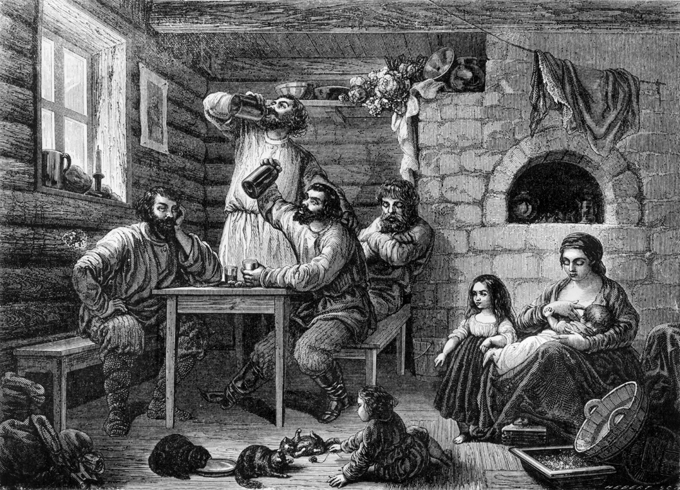History of Russian vodka in pictures

A type of distilled liquor designated by the Russian word vodka came to Russia in the late 14th century. In 1386, the Genoese ambassadors brought the first aqua vitae ("the water of life") to Moscow and presented it to Grand Duke Dmitry Donskoy. The liquid obtained by distillation of grape must was thought to be a concentrate and a "spirit" of wine (spiritus vini in Latin), from where came the name of this substance in many European languages (like English spirit, or Russian спирт, spirt)
A type of distilled liquor designated by the Russian word vodka came to Russia in the late 14th century. In 1386, the Genoese ambassadors brought the first aqua vitae ("the water of life") to Moscow and presented it to Grand Duke Dmitry Donskoy. The liquid obtained by distillation of grape must was thought to be a concentrate and a "spirit" of wine (spiritus vini in Latin), from where came the name of this substance in many European languages (like English spirit, or Russian спирт, spirt)

According to a legend, around 1430, a monk named Isidore from Chudov Monastery inside the Moscow Kremlin made a recipe of the first Russian vodka. Having a special knowledge and distillation devices, he became the creator of a new, higher quality type of alcoholic beverage. This "bread wine", as it was initially known, was for a long time produced exclusively in the Grand Duchy of Moscow and in no other principality of Rus'(this situation persisted until the era of industrial production). Thus, this beverage was closely associated with Moscow
According to a legend, around 1430, a monk named Isidore from Chudov Monastery inside the Moscow Kremlin made a recipe of the first Russian vodka. Having a special knowledge and distillation devices, he became the creator of a new, higher quality type of alcoholic beverage. This "bread wine", as it was initially known, was for a long time produced exclusively in the Grand Duchy of Moscow and in no other principality of Rus'(this situation persisted until the era of industrial production). Thus, this beverage was closely associated with Moscow

Until the mid-18th century, the drink remained relatively low in alcohol content, not exceeding 40% ABV. Multiple terms for the drink were recorded, sometimes reflecting different levels of quality, alcohol concentration, filtering, and the number of distillations; most commonly, it was referred to as "burning wine", "bread wine", or even in some locations simply "wine".
Until the mid-18th century, the drink remained relatively low in alcohol content, not exceeding 40% ABV. Multiple terms for the drink were recorded, sometimes reflecting different levels of quality, alcohol concentration, filtering, and the number of distillations; most commonly, it was referred to as "burning wine", "bread wine", or even in some locations simply "wine".

In some locations, grape wine may have been so expensive that it was a drink only for aristocrats. Burning wine was usually diluted with water to 24% ABV or less before drinking. It was mostly sold in taverns and was quite expensive. At the same time, the word vodka was already in use, but it described herbal tinctures (similar to absinthe), containing up to 75% ABV, and made for medicinal purposes.
In some locations, grape wine may have been so expensive that it was a drink only for aristocrats. Burning wine was usually diluted with water to 24% ABV or less before drinking. It was mostly sold in taverns and was quite expensive. At the same time, the word vodka was already in use, but it described herbal tinctures (similar to absinthe), containing up to 75% ABV, and made for medicinal purposes.

The first written usage of the word vodka in an official Russian document in its modern meaning is dated by the decree of Empress Elizabeth of 8 June 1751, which regulated the ownership of vodka distilleries. By the 1860s, due to the government policy of promoting consumption of state-manufactured vodka, it became the drink of choice for many Russians
The first written usage of the word vodka in an official Russian document in its modern meaning is dated by the decree of Empress Elizabeth of 8 June 1751, which regulated the ownership of vodka distilleries. By the 1860s, due to the government policy of promoting consumption of state-manufactured vodka, it became the drink of choice for many Russians

In 1863, the government monopoly on vodka production was repealed, causing prices to plummet and making vodka available even to low-income citizens. The taxes on vodka became a key element of government finances in Tsarist Russia, providing at times up to 40% of state revenue
In 1863, the government monopoly on vodka production was repealed, causing prices to plummet and making vodka available even to low-income citizens. The taxes on vodka became a key element of government finances in Tsarist Russia, providing at times up to 40% of state revenue

By 1911, vodka comprised 89% of all alcohol consumed in Russia. This level has fluctuated somewhat during the 20th century, but remained quite high at all times
By 1911, vodka comprised 89% of all alcohol consumed in Russia. This level has fluctuated somewhat during the 20th century, but remained quite high at all times

During the late 1970s, Russian culinary author William Pokhlebkin compiled a history of the production of vodka in Russia, as part of the Soviet case in a trade dispute; this was later published as A History of Vodka. Pokhlebkin claimed that while there is a wealth of publications about the history of consumption and distribution of vodka, virtually nothing had been written about vodka production.
During the late 1970s, Russian culinary author William Pokhlebkin compiled a history of the production of vodka in Russia, as part of the Soviet case in a trade dispute; this was later published as A History of Vodka. Pokhlebkin claimed that while there is a wealth of publications about the history of consumption and distribution of vodka, virtually nothing had been written about vodka production.



